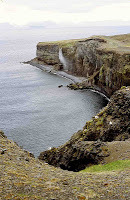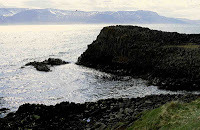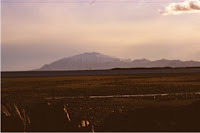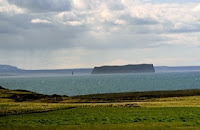Names for the Sea
 British writer Sarah Moss and I are kindred spirits. Shortly after I visited Greenland to see Viking Age archaeological sites in 2006, I read her novel Cold Earth, in which strange things happen during an archaeological investigation in Greenland. The novel remains one of my favorites, recommended to many friends, so it's no surprise I bought her memoir about a year in Iceland, Instead, I visit frequently and I read a lot about Iceland--though most of what I read disappoints me. American journalists always seem to have landed on some other island that bears no relationship to the Iceland I've known and loved since 1986. For one thing, I've spent very little time in the city of Reykjavik, particularly the city these journalists seem to find, with its "diverse milieu of funky cafes, cutting-edge restaurants and Icelandic-chic bars, all catering to a cozy chat society that hummed late into the infinite night" (NY Times, January 18, 2013), and where "half the country appears to take it as a professional obligation to drink themselves into oblivion and wander the streets until what should be sunrise" (Vanity Fair, April 2009).
British writer Sarah Moss and I are kindred spirits. Shortly after I visited Greenland to see Viking Age archaeological sites in 2006, I read her novel Cold Earth, in which strange things happen during an archaeological investigation in Greenland. The novel remains one of my favorites, recommended to many friends, so it's no surprise I bought her memoir about a year in Iceland, Instead, I visit frequently and I read a lot about Iceland--though most of what I read disappoints me. American journalists always seem to have landed on some other island that bears no relationship to the Iceland I've known and loved since 1986. For one thing, I've spent very little time in the city of Reykjavik, particularly the city these journalists seem to find, with its "diverse milieu of funky cafes, cutting-edge restaurants and Icelandic-chic bars, all catering to a cozy chat society that hummed late into the infinite night" (NY Times, January 18, 2013), and where "half the country appears to take it as a professional obligation to drink themselves into oblivion and wander the streets until what should be sunrise" (Vanity Fair, April 2009).Never seen it. Granted, I'm never out wandering the city streets in the wee hours looking for it. Reykjavik to me is a city of libraries, museums, and bookstores--especially bookstores, some of which I'll grant are funky (like the one inside the weekly flea-market at Kolaportid), and which I wish were open until what should be sunrise.
Sarah Moss, in Names of the Sea, doesn't dwell on the drunken nightlife. She's in Iceland to teach English literature at the university, with a husband and two young children in tow. But her Iceland is still not my Iceland. In a year she seems to have rarely left the city. And she never discovered the joys of the bookstores. She does not read Icelandic, she confesses. I'll forgive her that. Icelandic is a very difficult language to learn.
But Moss also doesn't seem to have read much Icelandic literature in translation. Particularly, in a whole year of living in the country, Moss doesn't seem to have read a single Icelandic saga.
That is harder for me to understand. Iceland without its sagas is just not Iceland. Iceland's medieval manuscripts, in which the sagas are preserved, "are at one and the same time the repository of medieval Icelandic culture and its visible symbol," according to the 2004 book The Manuscripts of Iceland. They are Iceland’s "main source of pride."
Only someone who had never read an Icelandic saga could write, as Moss does:
"The sagas are long narrative poems about the settlement years, which were first written down in the 12th and 13th centuries, several hundred years after the events they describe. In the 20th century, Icelandic historians questioned the status of the sagas as historical truth, and the poems are now widely seen as literary artefacts, but there is still something of the sacred text about them. Many Icelanders can quote the sagas in the way that 17th-century Puritans quoted the Bible. Every so often, a discussion in a faculty meeting will end with someone saying something in Icelandic alliterative verse. … everyone else will be nodding and agreeing, the issue somehow resolved, and I'll know the sagas have spoken again. They combine the functions of the Bible and the Domesday Book…"
Poems? Narrative poems?? At first I thought it was a typo, and Moss meant to say "the sagas are long narratives." But no, she repeats the word poems and even believes her fellow academics were quoting the sagas when they said something in alliterative verse. They were not.
 Moss has missed the whole point of the sagas' literary-historical importance. The Icelandic sagas are not poems. If someone was quoting alliterative verse, they were probably quoting the Poetic Edda, or maybe just a proverb.
Moss has missed the whole point of the sagas' literary-historical importance. The Icelandic sagas are not poems. If someone was quoting alliterative verse, they were probably quoting the Poetic Edda, or maybe just a proverb.The Icelandic sagas are "the envy of most world literatures," according to scholar William Ian Miller, because they are not poems: The sagas are written in prose. About 40 tales, some as quick as a short story, others stretching to several volumes in today’s paperback translations, make up the corpus. They tell of Iceland’s Golden Age, the Saga Age, 400 years of a free republic before the island succumbed to Norwegian rule in 1262. And they tell it beautifully: "This is not only the stuff of art," said Miller, "it is the stuff of a confident art that needs no instruction in sophistication."
In the 13th century, when verse was the norm in Europe, Icelanders were writing a vernacular prose that "achieved a height of excellence which can only be paralleled in modern times," declared E. V. Gordon, author of the standard Old Icelandic grammar book.
Peter Hallberg, who wrote a college text on the sagas, compared their style to Hemingway’s, with its simple, lucid sentence structure and finely calculated artistic effects. And there is none of that “metaphysical brooding,” in Hallberg’s words, that make medieval works like Dante’s Divine Comedy, for example, so tedious.
 The sagas are Iceland’s claim to literary fame. Literary scholars have called them "muscled, powerful narratives" that are surprising in their "seductiveness." They have inspired countless authors, from Kipling and Longfellow to Milan Kundera and Günter Grass.
The sagas are Iceland’s claim to literary fame. Literary scholars have called them "muscled, powerful narratives" that are surprising in their "seductiveness." They have inspired countless authors, from Kipling and Longfellow to Milan Kundera and Günter Grass. J. R. R. Tolkien found much of his Middle Earth in Icelandic literature; he and C. S. Lewis started a saga-reading club at Oxford University and translated the texts from Old Norse, the Viking language.
Another saga translator was the Victorian writer and designer William Morris. Asked once if he was going on a trip to Iceland, Morris replied, "No, I am going on a pilgrimage to Iceland."
 Quoting Morris, the Argentine poet Jorge Luis Borges said, "This is also my answer. Any specialist in Anglo-Saxon literature is sooner or later drawn to Icelandic literature. It is like admiring a sunset or falling in love."
Quoting Morris, the Argentine poet Jorge Luis Borges said, "This is also my answer. Any specialist in Anglo-Saxon literature is sooner or later drawn to Icelandic literature. It is like admiring a sunset or falling in love." The American novelist Jane Smiley ranks the sagas beside the works of "Homer, Shakespeare, Socrates, and those few others who live at the very heart of human literary endeavor."
I enjoyed Names for the Sea. It was fun to see Iceland through the eyes of a sensitive observer to whom everything was new--the light on the mountainsides, the cruel shapes in the lava, the misty rain, the ever-present sea. I envied her her ability to knit. But Moss's Iceland--without sagas!--is not my Iceland.
Join me again next Wednesday at nancymariebrown.blogspot.com for another adventure in Iceland and the medieval world.
Published on June 27, 2013 08:11
date newest »
newest »
 newest »
newest »
message 1:
by
Viktoría
(new)
Jul 16, 2013 11:39AM
 I love the way you write. It is very beautiful! It would be an honor to meet you one day. Keep writing and many thanks for the novels you have already published. They have become some of my most cherished books, especially The Far Traveler. Blessed be!
I love the way you write. It is very beautiful! It would be an honor to meet you one day. Keep writing and many thanks for the novels you have already published. They have become some of my most cherished books, especially The Far Traveler. Blessed be!
reply
|
flag



